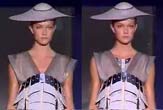Plunging Necklines: New Transformer Clothes

Fashion designer Hussein Chalayan is showing a set of unusual creations, "Transformer" dresses that owe more to technology than haute couture. Following in the footsteps of Howard Hughes, who designed the underwire bra for actress Jane Russell, Chalayan teamed up with engineering firm 2D3D to create dresses that transformed themselves.
For example, one of the Chalayan dresses has a moving neckline; the decolletage of the dress changed from somewhat risque to very modest.
Each dress was designed to morph through three decades of fashion change. The moving neckline dress also uses vertical slats that puff out to become more revealing. Other dresses zip or unzip themselves and transform in a variety of intriguing ways (see video).
The engineering effort underlying the fashion was extensive. 2D3D director Rob Edkins described some of the technology:
"With the first dress, the girl walked on in a 1906 costume, and it morphed from 1906 to 1916 and then to 1926... "Basically, the dresses were driven electronically by controlled, geared motors. We made... little pads for the models... within these containers we had all the battery packs, controlling chips--the microcontrollers and microswitches--and little geared motors. The motors we used were tiny, about a third of the size of a pencil and nine millimeters in diameter. Each of the motors had a little pulley, and the pulley was then attached to this monofilament wire which was fed through hollow tubes... running everywhere, carrying these little cables, each doing its little job, lifting things up or releasing little linked metallic plates. There was a huge amount of stuff going on beneath the clothes."
Science fiction writer J.G. Ballard had a very similar idea for clothing that transformed itself in his 1970 short story Say Goodbye to the Wind. In the story, special bio-fabrics actually made clothing come alive for the wearer in exactly the same way as the Chalayan dresses:
One drawback of bio-fabrics is their extreme sensitivity... The sudden movement of someone nearby, let alone of the wearer, brings an immediate reply from the nerve-like tissues. A dress can change its color and texture in a few seconds, becoming more decollete at the approach of an eager admirer, more formal at a chance meeting with a bank manager. (Read more about bio-fabric)
Bio-fabric is still a science-fictional idea, but I wonder what Hussein Chalayan could make with these real-life fabric technologies:
- Chameleon T-Shirts With Electrochromic PolymersChameleon t-shirts that can mimic a background, or replay any patterns at will?
- Smart Yarn Made From Carbon NanofiberThe researchers created the yarn by growing a mat of fibres on a substrate, called a nanotube forest.
- Scentsory Bodysuit: Biometric FashionThe Scentsory Chameleon Bodysuit is a "smart second skin" with integrated printed organic opto-electronics and integrated flexible nano-genetic devices on textiles.
Read more about Chalayan design.
Sign up for the Live Science daily newsletter now
Get the world’s most fascinating discoveries delivered straight to your inbox.
(This Science Fiction in the News story used with permission from Technovelgy.com - where science meets fiction.)










